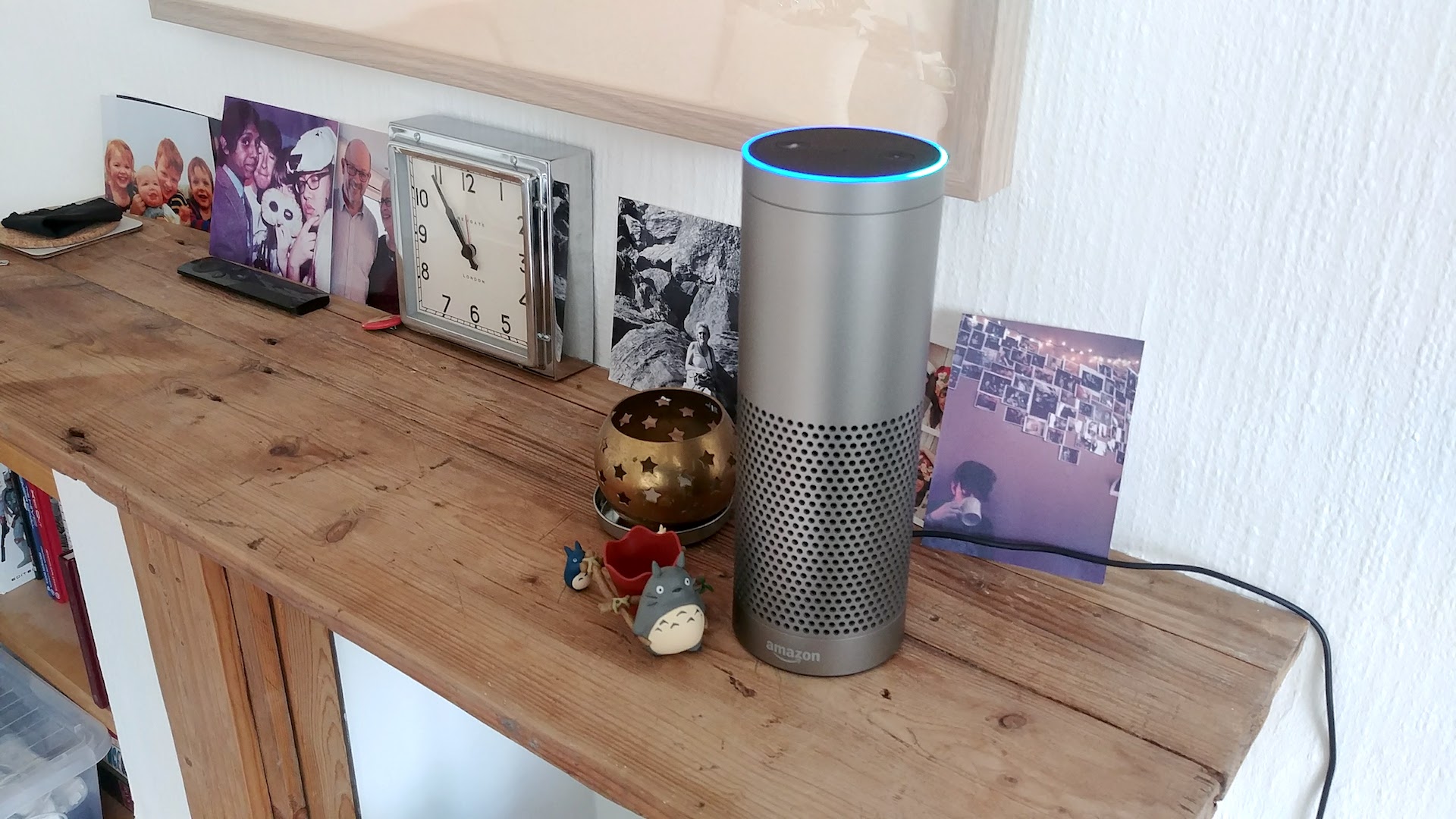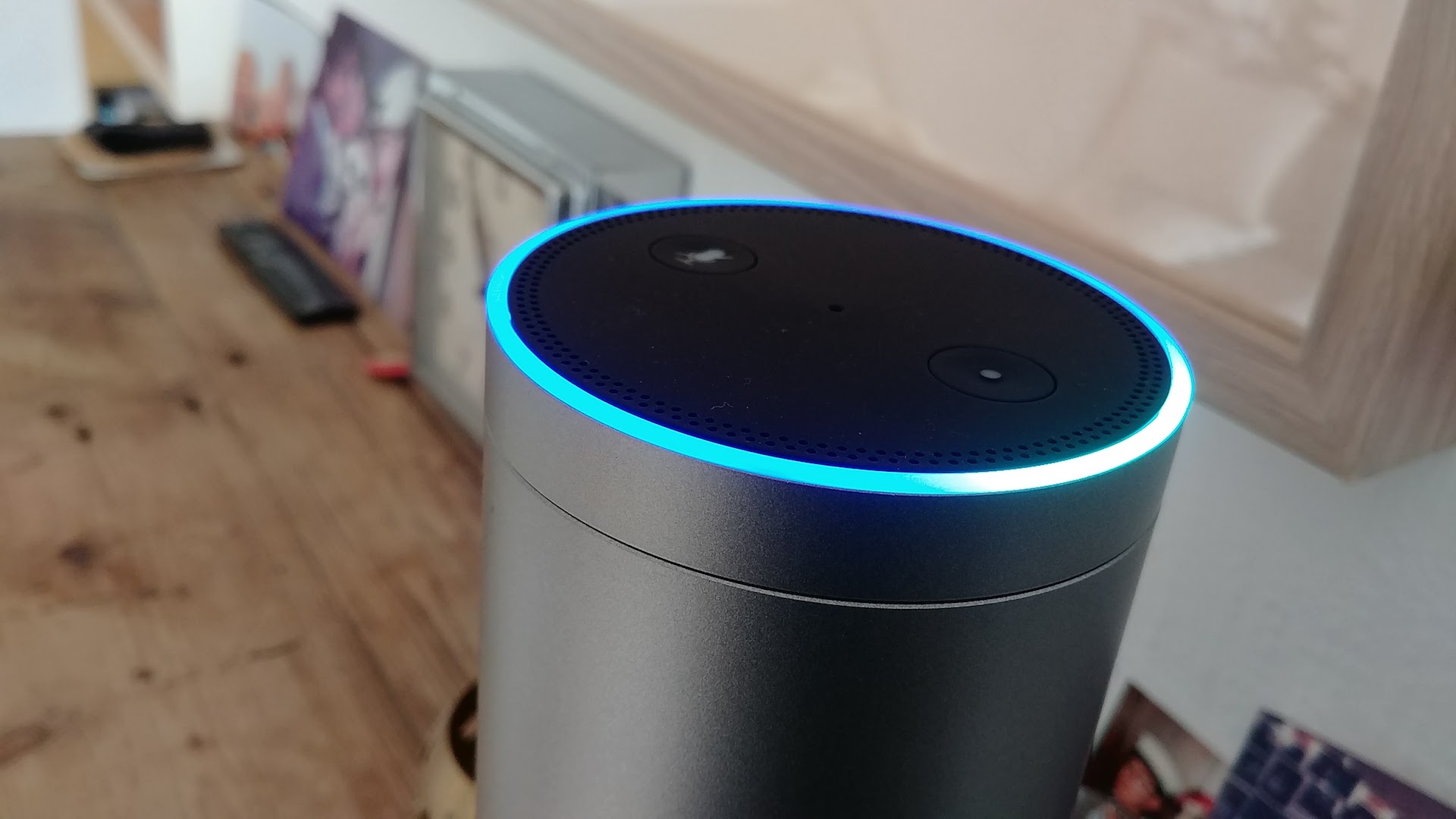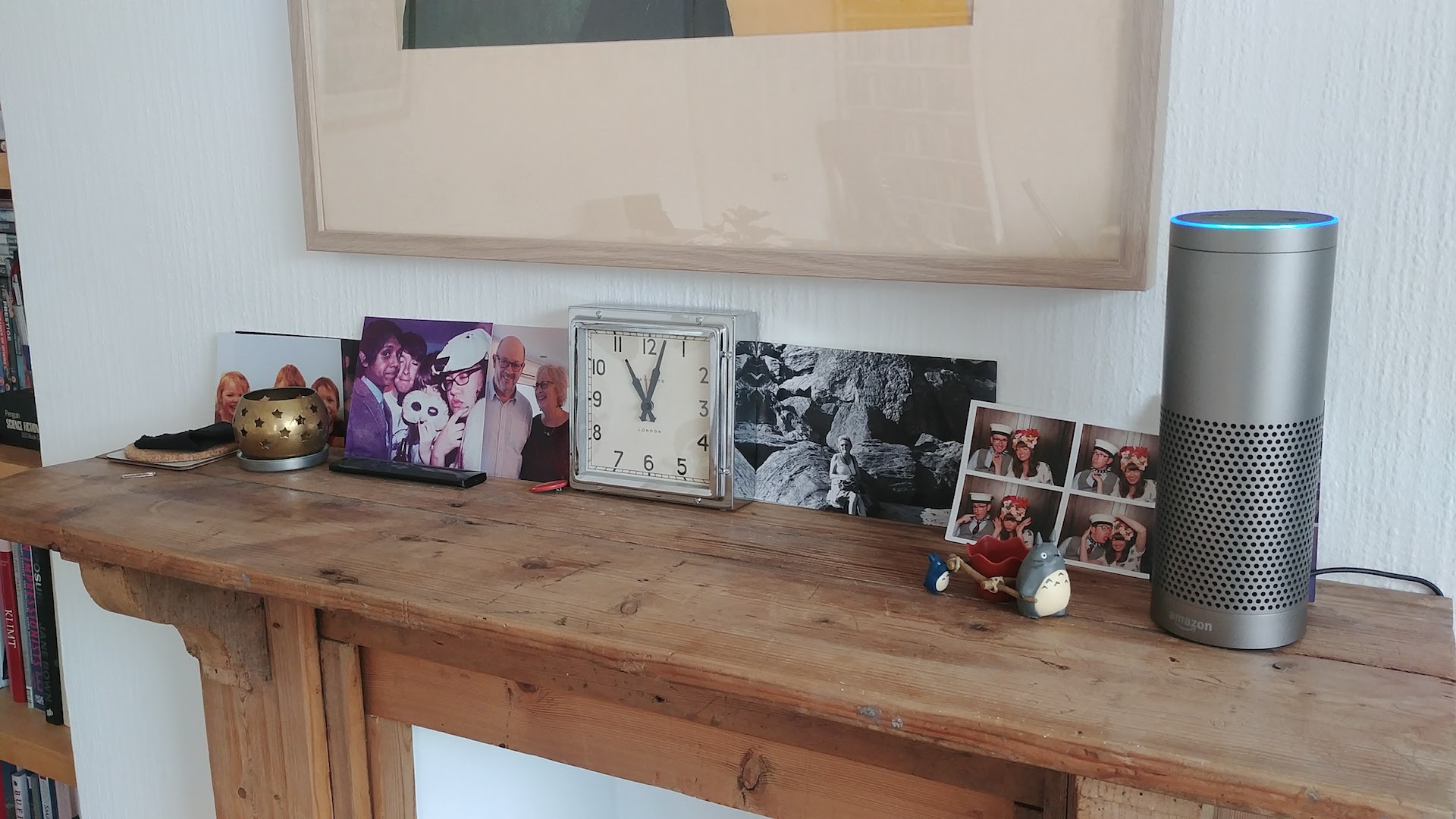TechRadar Verdict
Amazon's top-of-the-line Echo Plus impresses, even if the new features need some work. We've since seen a second generation model, but the original still makes an impact.
Pros
- +
Alexa voice control still amazes
- +
Improved audio
- +
A one-box smart home solution
Cons
- -
Sound quality could still be better
- -
Smart hub features need work
Why you can trust TechRadar
The Amazon Echo Plus may have been usurped by the 2nd-gen Echo Plus and more recently, the Amazon Echo (2019), but it's still a good choice if you're on a budget.
Amazon’s hugely popular Echo line-up of smart speakers has brought smart voice assistants well and truly into the mainstream, and for many buying one is the first step in buying into the smart home ecosystem.
Even if you’re not buying one of Amazon’s range and want to opt for a hi-fi or portable speaker instead, it’s still highly likely that you'll be considering one with either Amazon's own Alexa voice assistant, Google Assistant, or Apple's Siri built-in.
But if you’re after a smart speaker that combines voice-assisted smarts with great audio, then one of your best bets is the Amazon Echo Plus.
If sound quality and good connectivity are two of the most important considerations in your hunt for a new speaker, then the premium Echo Plus is certainly one to consider. You won't get the Dolby Atmos surround sound of the Echo Studio, but it's definitely better than the original Echo.
Unless you like the idea of popping in a screen too, in which case you'd be better off considering the Echo Show or Echo Spot.
Audio on this first version of the Echo Plus still gets a considerable upgrade over the less-expensive standard Echo, even if it’s not as quite up to the standards of rivals like the Sonos One.
Sign up for breaking news, reviews, opinion, top tech deals, and more.
However, audio quality is only part of the picture – the Amazon Echo Plus wants to be the center of your smart home, and includes a built in smart device bridge hub, meaning you won't need a separate unit plugged in for each of the other compatible devices (from smart light bulbs to thermostats) that you may want to pair with it.
Nowadays, you can find the original Echo Plus with hefty discounts (if you can find it at all).
- Can't decide between Amazon, Apple and Google? Check out our Amazon Echo vs Google Home vs Apple Homepod showdown.
Amazon Echo Plus FAQ: quick questions answered
What does an Echo Plus do?
Think of the Amazon Echo Plus as your own personal assistant. We’re not at the stage where our tech can physically help us run our homes, but it can do everything else. So you can ask the Plus’ voice assistant, Alexa, to answer questions about the time, general knowledge, traffic, what the weather is going to be like and everything else that might help your day run a bit smoother.
Thanks to smart home tech all connecting up, you can also use your Echo Plus to control other devices that you might have in your home. So let’s say you have a Philips Hue lightbulb, for example, the Echo Plus can control that too. You’d just need to say “Alexa, turn off the bulb.”
That’s just the beginning. The Echo Plus has a whole host of ‘skills’ which you can think of as separate apps and things it can do for you, from playing games to controlling other tech to waking you up in the morning.
Is Echo Plus better than Echo?
The Echo Plus is an upgraded and more expensive version of the regular Echo. The most notable difference is it’s got a better speaker built-in, which means audio sounds higher quality.
What devices work with an Echo Plus?
There are lots of devices that work with the Echo Plus. Including smart home interface ZigBee, the Philips Hue smart lighting system, Samsung SmartThings devices and many more. It’s worth checking whether the next smart home device you buy is Alexa-enabled – chances are these days it will be.
Does the Echo Plus have to be plugged in?
Yes it does. It needs to be connected to the mains to work.
Is there a monthly fee for an Echo Plus?
No, there’s no monthly fee. You just need to buy the Echo Plus and have an Amazon account. You’ll then need to get the Amazon Echo app, which is also free.
However, if you’re an Amazon Prime member you’ll get some added benefits, like access to Amazon Music through your Echo Plus.

Design
The Amazon Echo Plus looks almost identical to the original Echo, released in 2015. At heart, it's a industrial metal cylinder. But its small footprint lets it fit almost anywhere in your kitchen or living room.
It is 235mm tall and 84mm wide, if you want to get the tape measure out to plan where to put the speaker. The Echo Plus is available in black and white, just like the standard Echo. But the most interesting improvement design-wise is the addition of a warm silver color option, like we're reviewing here.
A dotted speaker grille wraps around its sides, reaching half-way up the speaker. The upper part is brushed aluminium, and the Echo Plus is capped off with a color-changing light ring around its upper edge. This is used to show everything from volume level to listening modes and connectivity issues.
With its grille and metal casing, the Echo Plus certainly looks like more of a mechanical gadget than the regular Echo, which manages a more neutral look thanks to its squatter shape and fabric outer.

Whereas the new Echo looks to slip into the background of your room, the Echo Plus more obviously proclaims its gadget status.
You'll control the Echo Plus with your voice for the most part, but two hardware buttons sit on the Echo Plus's top. One mutes the mic, the other activates Alexa without using the trigger “Alexa” command. A rotating ring on the top also lets you alter volume, another feature carried forward from previous Echoes.
The Echo Plus needs to be as good at hearing sound as playing it. It has seven far-field mics dottes around its top plate. It can hear your voice from several meters away, even if there's ambient noise in the room. The mic array is very effective, making this smart speaker even better at understanding you than the Sonos One.
The top part of the Echo Plus is dedicated to listening, but the column below is all about sound. It houses a 2.5-inch woofer and an 0.8-inch tweeter, and there's Bluetooth to let you connect another speaker if you need even more power.
There’s also a 3.5mm audio jack output port on the rear, a feature previously exclusive to the Echo Dot. Note that this isn’t a portable speaker, and will need a constant power supply and Wi-Fi connection in order to work effectively.
Performance
After a simple set-up process that links your Echo Plus to your Alexa phone app and home Wi-Fi connection, you’re ready to start slinging voice commands at the smart speaker.
The basics, like playing songs from Amazon Music or asking general knowledge questions, are baked into Alexa. You can add to its abilities too with "Skills".
There are already more than 30,000 of them to try. You add them to your Echo Plus in the Alexa app, and each adds to the commands the speaker will understand. The idea is that you can have a conversation with the speaker, with the device acting like a little audio butler to serve your every whim. You can check out our pick of the best Alexa Skills in our comprehensive rundown, and some fun Alexa Easter Eggs to try out too.
Alexa can play songs from Amazon’s own audio services or third-party streaming options like Spotify or TuneIn Radio. You can ask Alexa to control the temperature of a linked thermostat, or brightness of connected lighting. Ask Alexa a question and the female-voiced digital assistant will attempt (with a satisfyingly high success rate) to find and relay an answer from the internet, usually from Wikipedia. The uses are many and varied, from booking a taxi through Uber to ordering a pizza, or setting a wake up alarm.

When an Echo Plus (or any Echo, for that matter) is able to correctly identify your request and act upon it, it’s a magical feeling, a little slice of that Jetsons future in your home. You’ll never get tired of turning off the lights with a voice command alone. And the mic array performance is admirably sensitive, identifying voices from a distance, even over ambient noise that it may be generating loudly itself.
However, it still needs some work contextualising some natural language patterns that it can’t identify, and the magic fades when it misunderstands or mishears your commands. Whether that’s Alexa struggling to find a musical artist that you know is available through your streaming service of choice, or (as happened with us) having Alexa mistakenly order a pricey Nintendo Switch, its errors are all the more frustrating by virtue of the fact it so often works perfectly.
This is where Google has the upper hand, as its Assistant tends to understand commands Alexa doesn't.
A little slice of that Jetson’s future in your home.
Amazon Alexa improvements arrive all the time, though.
First up is Routines, which let you create custom phrases to trigger or schedule a number of actions that occur at once. For instance, you could create an “Alexa, I’m home” command, which could then turn on your heating and lights and rattle off your to-do list. They’ll only become more powerful as more third-party Skills become compatible with the feature, making for a versatile new addition.
The second notable new feature is the ability to place calls through an Echo. This has been available in the US for a little while, but has reached other territories, including the UK too. The Alexa app scans your contacts book for email addresses associated with an Echo device that has enabled calling, and then you simply ask Alexa to place a call. It’s a quick and easy way to get in contact with a pal. Note that all these new features will be coming to other Echo devices, too, and aren’t exclusive to the Plus.
Amazon has also recently rolled out a new beta feature called CanFulfillIntentRequest, which will let the developers of Skills tell Amazon the kind of questions their tool can answer. What this means is that if a user makes a vague request, the new feature will scan all of the Skills in its database to find the one most likely to respond appropriately. So there’s no more confusion if you forget the triggers to specific Skills! Hurrah!
And there are plenty, plenty more on the cards soon. One update that's really got us excited is the ability for Alexa to more naturally understand what we're blabbing on about. Starting soon, you won’t have to constantly say Alexa’s name to get her attention during a conversation - Alexa will just keep listening and responding until you’re finished asking questions.
Alexa Brain’s head, Ruhi Sarikaya, says these improvements will roll out to US, UK and Germany first, but refrained to give an exact date as to when we could expect the update to hit. Watch this space.
Sound
The Amazon Echo Plus is the most well-equipped smart speaker that the company has so far put out, at least in the audio stakes. With an improved driver array, and some digital processing tinkering now supplied by Dolby, the 360-degree omnidirectional audio output is notably more impressive than its predecessors. It’s a room filling sound at high volume levels, with little of the top-level distortion that affected earlier Echoes.

However, it’s still not quite a replacement for a high end audio system. Bass response, while improved, is still weak compared to the likes of Sonos (which now also offers Alexa support), or premium dedicated speaker sets. There’s plenty of detail in the top-end electro beeps of Fischerspooner’s Emerge, for instance, but that thumping bassline doesn’t kick home quite like it could. But every delicate pluck and slide of Nick Drake’s guitar on River Man is well represented, and his voice cuts through with a natural warmth.
It’s a room filling sound at high volume levels, with little of the top-level distortion that affected earlier Echoes.
It’s a good sounding speaker, then, but not necessarily worth an upgrade from an original Echo, and certainly not a replacement for an audiophile’s gear. You can easily hook the Echo Plus up to another speaker over a Bluetooth connection or via the 3.5mm audio jack. But with the pocket-money priced Echo Dot letting you do the same, and offering all the same smart functionality of the Plus (minus the ability to act as a smart home hub), you’d have to question in that case if it’d be more economical to just get the smaller option and connect that to a better sound system.
Smart functionality
Now, as we’ve discussed, Amazon’s Echo line up is no stranger to smart home control. Since the first Echo was released, you’ve been able to ask Alexa to control everything from thermostat settings to smart locks and more with a voice command alone. But where previous Echos achieved this by interfacing with a product’s own smart home hub or bridge, the Plus itself also has ZigBee wireless protocol smarts built in. Devices that work with the standard can interact with the Echo Plus speaker directly, bypassing the need for a standalone hub unit.
Philips Hue lights use Zigbee, which is why Amazon bundles the Echo Plus with a bulb.
It’s an efficient system – there’s no need to lose a plug socket to multiple smart device hubs. Other smart devices that support Zigbee include Samsung SmartThings, IKEA's smart lights, Osram Lightify and Honeywell's smart thermostat.
That said, ZigBee is just one of many smart home standards. And a lot of smart gear simply uses Echo Plus's standard Wi-Fi communication rather than Zigbee.

We noticed some interesting issues when trying to hook up Philips Hue connected light bulbs to the Amazon Echo Plus too. The Alexa app has a process that searches for Internet of Things devices in your house when activated, but it simply couldn’t find the Hue bulbs around our house, even when factory resetting the bulbs. And yet, when issuing a voice command to trigger the same device-searching action, the Echo Plus found them without any issues.
Once connected, the Philips Hue bulbs worked with voice commands without a hitch, switching off, changing color and dimming with just a wobble of the larynx. But it’s not quite the same experience as using Hue bulbs removed from Amazon’s smart ecosystem.
The Philips Hue bulbs are usually paired with the company’s own Philips Hue Bridge, which lets you access the bulbs across your network and through apps. However, whether it’s a lack of Hue app updates or support from Amazon which is to blame, the Hue app currently cannot interact with the bulbs without the Bridge present, which undermines the Plus’s ‘one hub to rule them all’ selling point. So in the case of the Hue bulbs, that means you lose granular control over the shade of each bulb.
While many leading smart home devices will work with the Plus, a significant selection won’t.
Hue is only one device set from a broad smart ecosystem, but one of the most popular and widely used. However, Alexa can also control thousands of devices that don't use Zigbee too. After all, other Echo units don't have Zigbee hardware inside.
Right now Alexa also has the widest support for smart home devices, beating Google Home. Before buying it's a good idea to see whether the smart gadgets you daydream about support Alexa. You'll usually see it described as "works with Alexa" if it does.
Verdict
Although Amazon's smart assistant Alexa isn't perfect, it’s easy to recommend the Amazon Echo Plus. It’s a convenient one-stop solution for both audio, smart assistant functions and Internet of Things controls, with Alexa still going strong as the most feature-rich voice assistant.
But the strength of the Echo range, especially at the lower price tiers, still makes these top-of-the-line models a harder sell. The Echo Dot has comparable smarts for a fraction of the price, it just doesn't sound as good. Likewise, the built-in smart hub is a great addition, but isn’t yet feature-complete, meaning committed smart home users may not want to make the jump just yet.
In short, if you’re looking to enter the world of the connected home, the Echo Plus is a great place to start. Just be aware that more economical options may, for the time being at least, suit your needs just as well.
Image Credits: TechRadar.
- The entire Amazon Echo speaker line-up explained: which is right for you?
- The best smart speakers 2019: which one should you buy?

Gerald is Editor-in-Chief of Shortlist.com. Previously he was the Executive Editor for TechRadar, taking care of the site's home cinema, gaming, smart home, entertainment and audio output. He loves gaming, but don't expect him to play with you unless your console is hooked up to a 4K HDR screen and a 7.1 surround system. Before TechRadar, Gerald was Editor of Gizmodo UK. He was also the EIC of iMore.com, and is the author of 'Get Technology: Upgrade Your Future', published by Aurum Press.
